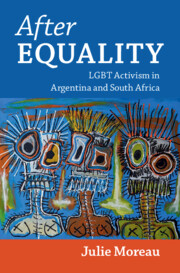Refine search
Actions for selected content:
6 results
5 - In the Flesh
-
- Book:
- After Equality
- Published online:
- 19 June 2025
- Print publication:
- 03 July 2025, pp 149-174
-
- Chapter
- Export citation
2 - Identity in Context
-
- Book:
- After Equality
- Published online:
- 19 June 2025
- Print publication:
- 03 July 2025, pp 42-86
-
- Chapter
- Export citation
1 - Intersectionality and the Strategic Use of Identity in Social Movements
-
- Book:
- After Equality
- Published online:
- 19 June 2025
- Print publication:
- 03 July 2025, pp 22-41
-
- Chapter
- Export citation
4 - Dilemmas of Success
-
- Book:
- After Equality
- Published online:
- 19 June 2025
- Print publication:
- 03 July 2025, pp 119-148
-
- Chapter
- Export citation
3 - Making Identity Work
-
- Book:
- After Equality
- Published online:
- 19 June 2025
- Print publication:
- 03 July 2025, pp 87-118
-
- Chapter
- Export citation

After Equality
- LGBT Activism in Argentina and South Africa
-
- Published online:
- 19 June 2025
- Print publication:
- 03 July 2025
